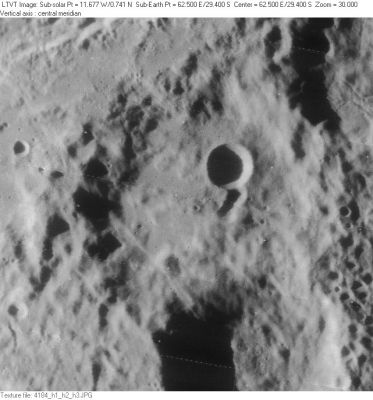Hase
Contents
Hase
|
Lat: 29.4°S, Long: 62.5°E, Diam: 83 km, Depth: 3.52 km, Rükl: 59 |
LO-IV-184H The deeply shadowed 14-km circular crater on the floor of Hase is Hase A. 56-km Hase D partially overlays Hase on the south, while Hase itself seems to overlay 41-km Palitzsch in the upper right.
Images
LPOD Photo Gallery Lunar Orbiter Images Apollo Images
Maps
(LAC zone 98C4) LAC map Geologic map
Description
Description: Elger
(IAU Directions) HASE.--An irregular formation, about 50 miles in diameter, on the S.E. of Petavius, with which it is connected by extensions of the E. and W. walls of the latter. Its rampart, some 7000 feet above the floor, is broken by depressions on the E.; and on the S. is bounded by a smaller ring-plain with still loftier walls. Schmidt shows a large crater and three smaller ones on the E. side of the floor.
Description: Wikipedia
Additional Information
- Depth data from Kurt Fisher database
Westfall, 2000: 3.52 km
Cherrington, 1969: 2.74 km - The isolated shadows from the west rim in LO-IV-184H indicate there are points at least 3300 m above the floor. Hase A is at least 2200 m deep (the shadows don’t reach to the deepest point). Hase D is much deeper (up to 5000 m). - Jim Mosher
- Included in ALPO list of bright ray craters
Patrick Moore: "To the outer northwest of Hase it has been said that the ridges show up at sunset as an illuminated cross, but I have yet to see this appearance, though I have often looked for it". (NEW GUIDE TO THE MOON, Patrick Moore, page 298-299). Research: Danny Caes.
Nomenclature
Johann Matthias; German mathematician (1684-1742).
LPOD Articles
Bibliography
